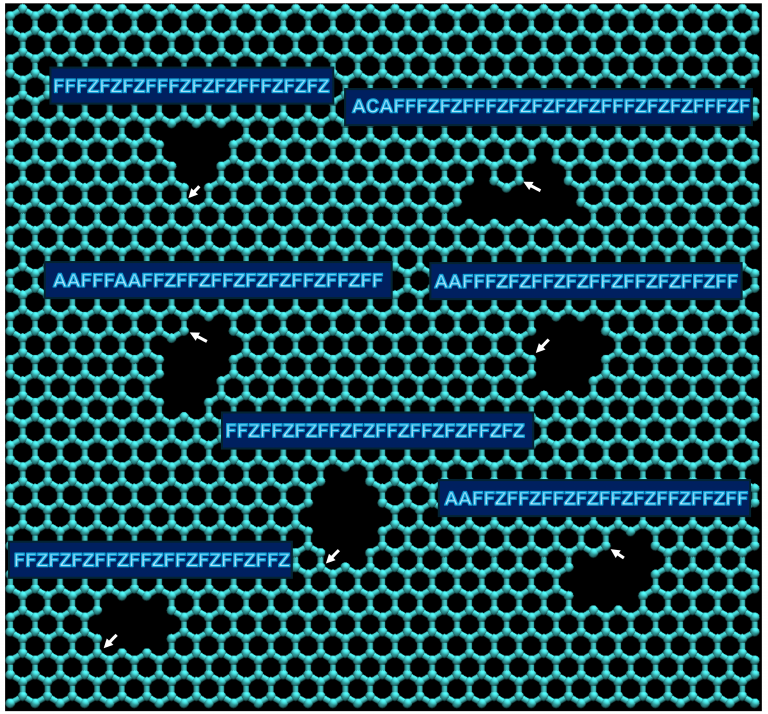Reviewed by Lexie CornerNov 21 2024
The lab of Ananth Govind Rajan, an assistant professor in the Department of Chemical Engineering at the Indian Institute of Science (IISc), has developed a new language that encodes the structure and shape of nanopores as a series of characters, according to a study published in the Journal of the American Chemical Society.
 A selection of nanopores that could be present in graphene along with their STRONG-based names. The white arrow indicates the starting atom, and each STRONG is written by traversing the nanopore rim atoms in an anti-clockwise direction. Image Credit: Piyush Sharma
A selection of nanopores that could be present in graphene along with their STRONG-based names. The white arrow indicates the starting atom, and each STRONG is written by traversing the nanopore rim atoms in an anti-clockwise direction. Image Credit: Piyush Sharma
A variety of 2D materials, such as graphene, can have nanopores—microscopic holes created by missing atoms that allow foreign substances to pass through. The characteristics of these nanopores influence the material's properties, enabling applications like gas sensing, seawater filtration, and even DNA sequencing.
The problem is that these 2D materials have a wide distribution of nanopores, both in terms of shape and size. You don’t know what is going to form in the material, so it is very difficult to understand what the property of the resulting membrane will be.
Ananth Govind Rajan, Assistant Professor, Department of Chemical Engineering, Indian Institute of Science
Machine learning models can be an effective method for analyzing nanopore structures and discovering new characteristics. However, these models often struggle to accurately depict the appearance of a nanopore.
The new language developed can be used to train machine learning models that predict nanopore characteristics across various materials.
The language, called STRONG (STring Representation of Nanopore Geometry), assigns distinct letters to different atom combinations and generates a sequence representing all the atoms on a nanopore’s edge to characterize its geometry. For example, a fully bonded atom (three bonds) is represented as ‘F,’ a corner atom (attached to two atoms) as ‘C,’ and so on. The properties of different nanopores are determined by the variations in the atoms at their edges.
STRONG enabled the team to develop efficient methods for identifying functionally similar nanopores with identical edge atoms, such as those connected by rotation or reflection. This approach significantly reduces the amount of data needed to estimate nanopore characteristics.
Similar to how ChatGPT predicts textual data, neural networks (machine learning models) can "read" the letters in STRONGs to predict what a nanopore will look like and what its characteristics will be. The researchers chose a type of neural network used in Natural Language Processing, which is effective with extended sequences and can selectively remember or forget information over time.
Unlike traditional programming, where specific instructions are given to the computer, neural networks can be trained to figure out how to approach problems they have not encountered before.
The team trained the neural network using a set of nanopore structures with known attributes (such as formation energy or gas transport barrier). This training data enables the network to generate an estimated mathematical function, which can then be used to predict the properties of a nanopore when its structure is represented by STRONG letters.
This also presents interesting possibilities for reverse engineering, such as designing a nanopore structure with specific desired features, which is particularly useful in applications like gas separation.
Using STRONGs and neural networks, we screened for nanoporous materials to separate CO2 from flue gas, a mixture of gases released on fuel combustion.
Piyush Sharma, Study First Author and Former Student, Indian Institute of Science
This procedure is essential for reducing carbon emissions. The researchers identified several potential structures that could effectively capture CO2 from an oxygen-nitrogen mixture.
The team is also exploring the idea of creating digital twins of 2D materials.
Rajan concluded, “Let’s say you collect a lot of experimental data on a material. You can then try to see what would have been the collection of nanopores which would have led to this performance. With this digital twin of the material, you can do a lot of things–predict the performance for the separation of a different set of gases, or you can come up with entirely new use cases for the same material.”
Journal Reference:
Sharma, P. et. al. (2024) Machine Learnable Language for the Chemical Space of Nanopores Enables Structure–Property Relationships in Nanoporous 2D Materials. Journal of the American Chemical Society. doi.org/10.1021/jacs.4c08282